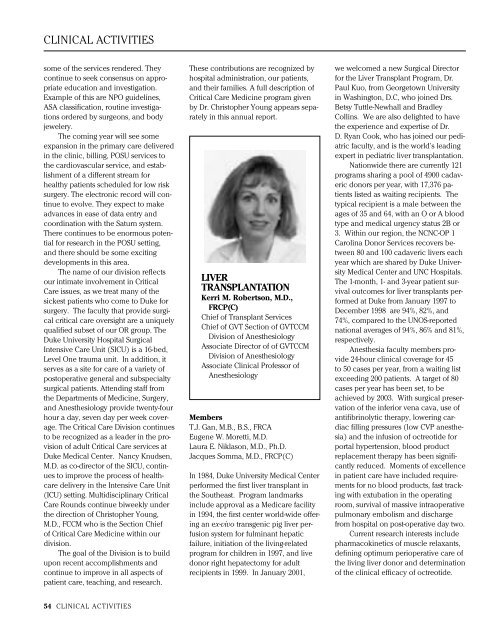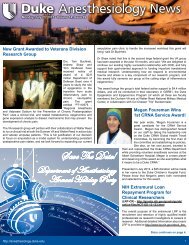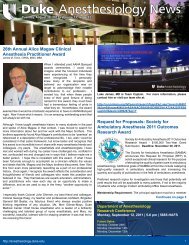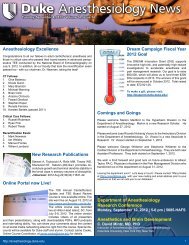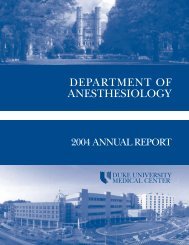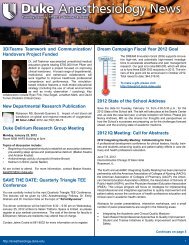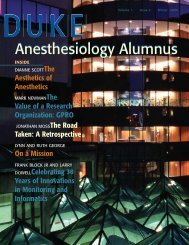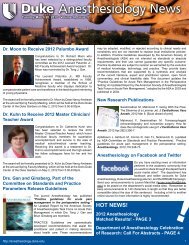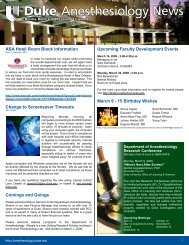DEPARTMENT OF ANESTHESIOLOGY ANNUAL REPORT
DEPARTMENT OF ANESTHESIOLOGY ANNUAL REPORT
DEPARTMENT OF ANESTHESIOLOGY ANNUAL REPORT
You also want an ePaper? Increase the reach of your titles
YUMPU automatically turns print PDFs into web optimized ePapers that Google loves.
CLINICAL ACTIVITIES<br />
some of the services rendered. They<br />
continue to seek consensus on appropriate<br />
education and investigation.<br />
Example of this are NPO guidelines,<br />
ASA classification, routine investigations<br />
ordered by surgeons, and body<br />
jewelery.<br />
The coming year will see some<br />
expansion in the primary care delivered<br />
in the clinic, billing, POSU services to<br />
the cardiovascular service, and establishment<br />
of a different stream for<br />
healthy patients scheduled for low risk<br />
surgery. The electronic record will continue<br />
to evolve. They expect to make<br />
advances in ease of data entry and<br />
coordination with the Saturn system.<br />
There continues to be enormous potential<br />
for research in the POSU setting,<br />
and there should be some exciting<br />
developments in this area.<br />
The name of our division reflects<br />
our intimate involvement in Critical<br />
Care issues, as we treat many of the<br />
sickest patients who come to Duke for<br />
surgery. The faculty that provide surgical<br />
critical care oversight are a uniquely<br />
qualified subset of our OR group. The<br />
Duke University Hospital Surgical<br />
Intensive Care Unit (SICU) is a 16-bed,<br />
Level One trauma unit. In addition, it<br />
serves as a site for care of a variety of<br />
postoperative general and subspecialty<br />
surgical patients. Attending staff from<br />
the Departments of Medicine, Surgery,<br />
and Anesthesiology provide twenty-four<br />
hour a day, seven day per week coverage.<br />
The Critical Care Division continues<br />
to be recognized as a leader in the provision<br />
of adult Critical Care services at<br />
Duke Medical Center. Nancy Knudsen,<br />
M.D. as co-director of the SICU, continues<br />
to improve the process of healthcare<br />
delivery in the Intensive Care Unit<br />
(ICU) setting. Multidisciplinary Critical<br />
Care Rounds continue biweekly under<br />
the direction of Christopher Young,<br />
M.D., FCCM who is the Section Chief<br />
of Critical Care Medicine within our<br />
division.<br />
The goal of the Division is to build<br />
upon recent accomplishments and<br />
continue to improve in all aspects of<br />
patient care, teaching, and research.<br />
54 CLINICAL ACTIVITIES<br />
These contributions are recognized by<br />
hospital administration, our patients,<br />
and their families. A full description of<br />
Critical Care Medicine program given<br />
by Dr. Christopher Young appears separately<br />
in this annual report.<br />
LIVER<br />
TRANSPLANTATION<br />
Kerri M. Robertson, M.D.,<br />
FRCP(C)<br />
Chief of Transplant Services<br />
Chief of GVT Section of GVTCCM<br />
Division of Anesthesiology<br />
Associate Director of of GVTCCM<br />
Division of Anesthesiology<br />
Associate Clinical Professor of<br />
Anesthesiology<br />
Members<br />
T.J. Gan, M.B., B.S., FRCA<br />
Eugene W. Moretti, M.D.<br />
Laura E. Niklason, M.D., Ph.D.<br />
Jacques Somma, M.D., FRCP(C)<br />
In 1984, Duke University Medical Center<br />
performed the first liver transplant in<br />
the Southeast. Program landmarks<br />
include approval as a Medicare facility<br />
in 1994, the first center world-wide offering<br />
an ex-vivo transgenic pig liver perfusion<br />
system for fulminant hepatic<br />
failure, initiation of the living-related<br />
program for children in 1997, and live<br />
donor right hepatectomy for adult<br />
recipients in 1999. In January 2001,<br />
we welcomed a new Surgical Director<br />
for the Liver Transplant Program, Dr.<br />
Paul Kuo, from Georgetown University<br />
in Washington, D.C, who joined Drs.<br />
Betsy Tuttle-Newhall and Bradley<br />
Collins. We are also delighted to have<br />
the experience and expertise of Dr.<br />
D. Ryan Cook, who has joined our pediatric<br />
faculty, and is the world’s leading<br />
expert in pediatric liver transplantation.<br />
Nationwide there are currently 121<br />
programs sharing a pool of 4900 cadaveric<br />
donors per year, with 17,376 patients<br />
listed as waiting recipients. The<br />
typical recipient is a male between the<br />
ages of 35 and 64, with an O or A blood<br />
type and medical urgency status 2B or<br />
3. Within our region, the NCNC-OP 1<br />
Carolina Donor Services recovers between<br />
80 and 100 cadaveric livers each<br />
year which are shared by Duke University<br />
Medical Center and UNC Hospitals.<br />
The 1-month, 1- and 3-year patient survival<br />
outcomes for liver transplants performed<br />
at Duke from January 1997 to<br />
December 1998 are 94%, 82%, and<br />
74%, compared to the UNOS-reported<br />
national averages of 94%, 86% and 81%,<br />
respectively.<br />
Anesthesia faculty members provide<br />
24-hour clinical coverage for 45<br />
to 50 cases per year, from a waiting list<br />
exceeding 200 patients. A target of 80<br />
cases per year has been set, to be<br />
achieved by 2003. With surgical preservation<br />
of the inferior vena cava, use of<br />
antifibrinolytic therapy, lowering cardiac<br />
filling pressures (low CVP anesthesia)<br />
and the infusion of octreotide for<br />
portal hypertension, blood product<br />
replacement therapy has been significantly<br />
reduced. Moments of excellence<br />
in patient care have included requirements<br />
for no blood products, fast tracking<br />
with extubation in the operating<br />
room, survival of massive intraoperative<br />
pulmonary embolism and discharge<br />
from hospital on post-operative day two.<br />
Current research interests include<br />
pharmacokinetics of muscle relaxants,<br />
defining optimum perioperative care of<br />
the living liver donor and determination<br />
of the clinical efficacy of octreotide.


